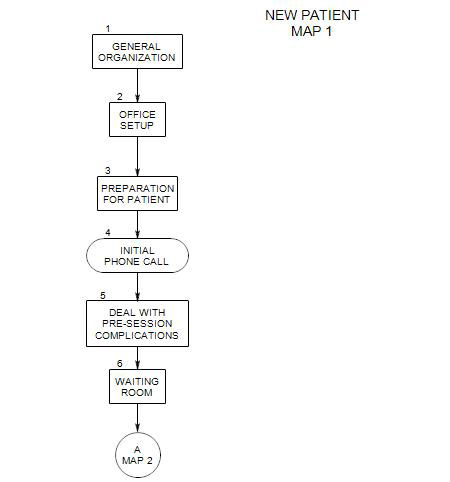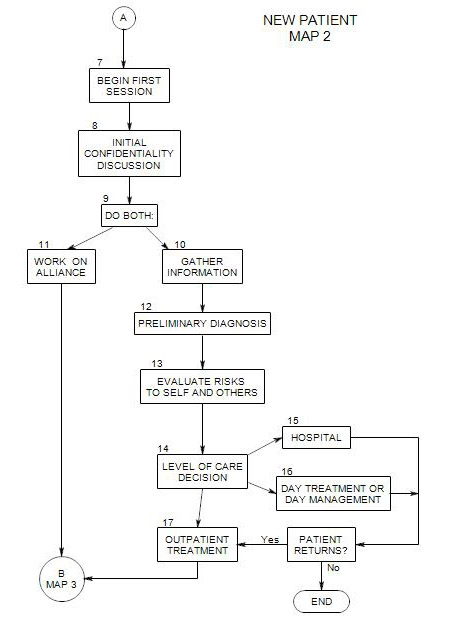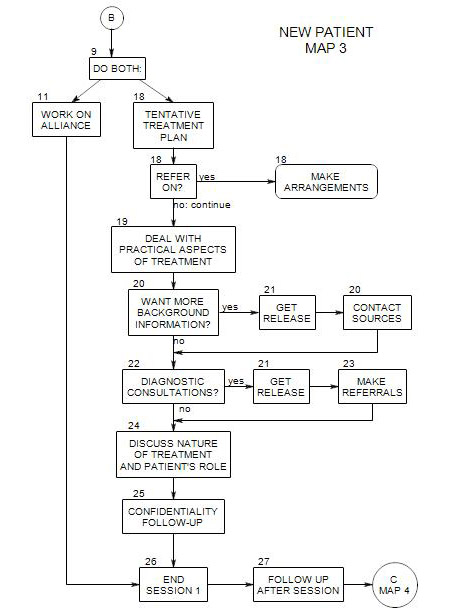-
Follows Section 7 on Map 2
In this section, we first discuss kinds of dangers that patients are likely to face, then consider degree of danger in each and its effect on treatment choices.
13a. Lethality
The danger that we are most concerned about is lethality: danger that the patient will suicide, hurt him/herself, or hurt others out of despair or anger, or from being disoriented, confused or impulsive. This could include danger to the therapist.
Danger of lethality may be suggested by-
- strong negative emotions: rage, hopelessness, despair, or guilt.
- thoughts of death as revenge, rebirth, getting even, self-punishment, atonement for sins, reunion with someone deceased.
- the idea of using one’s death to express strong feelings or to control others, e.g.: by inducing guilt.
- a difficulty communicating in less extreme ways.
- extreme risk-taking.
- an inability to assess the consequences of his/her behavior.
To evaluate lethality,-
- ask directly: Are you likely to hurt yourself?; or ask questions about suicidal or homicidal thoughts: Have you ever considered suicide?, and follow up with questions about the extent of fantasy, planning and preparation. Be careful not to lead the patient or suggest that suicide is a desirable solution. You can ask whether the patient has ever tried suicide in the past. If so, find out about it, and whether circumstances are similar in any way, etc. Prior attempts generally suggest greater risk.
- ask if anyone else in the person’s life has committed or attempted suicide, and if so, the patient’s reactions. [This is perhaps more important for an adolescent than an adult.]
- ask about environmental pressures, from job, family, friends, neighborhood, etc.
- determine whether the patient is accurately oriented and not psychotic.
- ask about comorbid conditions that could exacerbate the patient’s primary symptoms: If the patient is anxious or depressed, ask about substance abuse, obsessive-compulsive disorder, etc.
- make your own judgment about comorbid conditions, especially impulsivity or difficulty with relatedness.
Ask how the patient manages his/her symptoms. Some attempts to self medicate may introduce additional dangers, e.g.: risk taking or using alcohol. Others, like eating or shopping, may have uncomfortable long range consequences that lead to erosion of self esteem.
Information from family members can affect your judgment of the risk of suicide. Much of the above information about the patient can also be obtained from family members. For example, if the patient is seen as impulsive, then excessive risk-taking may be a sign of suicidality.
If the patient is more deliberate and planful, then signs of danger can include-
- neglect of self.
- increased interest in religion, or withdrawal from religion.
- talk of the wish to die, including comments about others being better off without the patient.
- increased interest in putting things in order, which can include giving away possessions.
13b. Risk of Lethality and Treatment Response
RISK IS RELATIVELY SMALL
When the risk is small, you may decide to begin on a regular schedule immediately, and simply schedule the next appointment. Ordinarily, these days, we assume weekly sessions, though of course there are many factors affecting session frequency.
RISK IS MODERATE
For moderate risk, you might want to offer the patient one or more of the following:
- calls between sessions, for reassurance, support, advice, interpretation, etc. For example, you might say, Call if you need to. I’ll be available off and on all weekend. Just leave a message and I’ll get back to you.
- more frequent sessions, possibly two or three per week. You might defer deciding on the number of sessions per week but because of the severity of the patient’s issues, offer to see him/her again the next day.
- Involving family or friends can take a variety of forms and be helpful in many ways.
RISK IS GREAT
If the patient appears to be at risk for suicide or other dangerous behaviors, then more serious interventions may be called-for:
- you might ask whether he/she can contract with you not to suicide before the next scheduled session.
- A contract could include a provision to call you or someone else if the risk seems great.
- You may also give the patient the number of another therapist or of suicide hot-lines to call if he/she feels at risk and is unable to reach you.
- If he/she is participating in AA or a similar organization, ask about his/her sponsor and about contacting that person in a time of crisis. A friend, family member, neighbor, etc., could also be helpful. In any of these cases, you will want to gauge the likelihood that the patient will call that person, and the person’s availability and willingness to help in this way. In some cases, you may need to contact the person yourself to verify his/her suitability.
- You can also discuss the possibility of going to a hospital emergency room if the patient is unable to reach you and can’t deal with the depression without you.
If the patient is unable to contract not to suicide, then you may have to insist on hospitalization, and possibly even call the police to escort the patient there.
PATIENT’S JUDGMENT IS COMPROMISED
- Means: possible psychotic process.
- Increases the possibility that hospitalization will be necessary, and suggests consulting with a professional who has admitting privileges at a hospital the patient might need to go to.
13c. Other Dangers
Of these, dangers to life and safety must be considered first, but the others are also very important. For example, a patient who is too depressed to go to work may lose the job, become more depressed, and enter a vicious spiral of increasing failure and depression.
Other dangers to consider are-
- discouragement: the patient’s belief that he/she can’t be helped, and possibly not returning for further treatment.
- medical risks, due to disease or inappropriate medications, and where the patient would benefit from a medical consultation.
- risks to health or safety, out of the patient’s failure to take adequate care of him/herself [not eating, not taking necessary medications, ignoring safety precautions, etc.]
- use of alcohol or other drugs to self-medicate. Changes in use.
- risks to others, especially the lives or safety of children or other dependents through failure to attend to or care for them adequately.
- legal danger to the patient: a danger that the person will put him/herself at legal risk.
- legal danger to the therapist: the danger of lawsuit, by the patient or others, against the therapist.
- loss of job through failure to carry out responsibilities.
- alienation of support, when the patient’s family or friends stop helping or start blaming; when the patient starts to feel ashamed and separate from others.
- manipulation, a risk that the patient will be taken advantage of by others because of his/her psychological vulnerability.
Also consider the patient’s felt need for help, and the patient’s subjective discomfort.
DISCOURAGEMENT
MEDICAL RISKS
RISKS TO HEALTH OR SAFETY
RISKS OF DRUG AND ALCOHOL USE
RISKS TO OTHERS
LEGAL DANGERS TO THE PATIENT
LEGAL DANGERS TO A THERAPIST
There are at least two risks here, that require different kinds of attention:
- Risk of being drawn into a legal contest between your patient and others or between two of your patients, if you are treating a couple or family
- Risk of malpractice lawsuit by your patient or someone connected to your patient.
In addition, your patient may be at risk in a variety of ways, including legal, due to poor judgment, impulsiveness, etc.
There is sometimes a risk of being drawn into legal action as an expert with knowledge of the patient. You should inquire about this possibility, and decide with the patient whether you can or are willing to provide forensic services. If so, try to anticipate the person’s need. If not, refer on.
RISK OF JOB LOSS
ALIENATION OF SUPPORT
There are many ways that this could happen:
- A depressed person could withdraw from others and drive them away, or become angry and antagonistic
- An anxious person could be seen as overly needy or intrusive, or just difficult.
- A paranoid person might be seen as dangerous or unpredictable
MANIPULATION
13e. Predictability and Treatability
These are important issues to consider from the beginning, because on the one hand, if the person is very unstable, then the form of treatment must be carefully chosen to increase his/her stability – possibly including inpatient care or the enlistment of family. On the other hand, a routine test for psychosis or basic skills could seem un-empathic to a better developed person, and drive him/her elsewhere.
- Assessing mental status is important, because it affects the probability that the patient will behave in a predictable way. A cautious assessment will assume that an unpredictable patient is more likely to be at risk.
- Assess short-term memory. Many issues can affect a person’s ability to remember information and accurately report it. A brief test could be to give the person something to remember at the start of the session, ask about it later on.
- Try to evaluate the person’s impulsiveness-deliberateness. Some history-taking about doing wild or impulsive things may be helpful.
- Watch for delusions: beliefs that are clearly impossible or highly unlikely. For example, that idea that the person’s every move is being watched by the CIA.
- Ask about hallucinations: did the person ever see or hear things that no one else saw or heard, or that clearly weren’t there? What were the circumstances? What was his/her reaction? How did he/she cope with it?
- Notice the patient’s level of cognitive functioning: vocabulary, abstract reasoning ability, etc.
13f. Medical Attention
If you discover that the patient has a medical condition that requires immediate attention, whether or not it seems directly related to the patient’s psychological symptoms or complaints, ask the patient to see his/her physician or go to a hospital emergency room.
This possibility justifies keeping medical information available.



